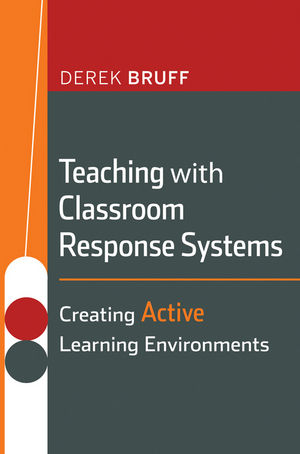Teaching with Classroom Response Systems: Creating Active Learning EnvironmentsISBN: 978-0-470-28893-1
Paperback
240 pages
February 2009, Jossey-Bass
 This is a Print-on-Demand title. It will be printed specifically to fill your order. Please allow an additional 10-15 days delivery time. The book is not returnable.
|
||||||
Bruff supplements his points on engagement and assessment with a classified array of clicker questions for a variety of teaching contexts. He also provides helpful advice on teaching choices with response systems: when to grade clicker questions, how to use them for summative assessment, and how to address cheating and lack of participation. He provides additional helpful suggestions on dealing with logistical issues such as system choice and troubleshooting. Throughout, the reader benefits from the copious examples gleaned from teachers.
This book convincingly demonstrates that clicker technology allows teachers and students to adapt quickly to emerging learning needs….Bruff’s work is an enthusiastic, accessible, and detailed introduction for all educators interested in this popular educational technology tool.”
—NACADA Journal, Issue 30(1) (Spring 2010)
“Dr. Bruff’s thoughtful description of effective practices with clickers, based on numerous interviews with higher education instructors, both reinforces and extends the knowledge base on response system use in higher education. The emphasis on pedagogical approaches will make this book useful and relevant for years to come, even as the technologies themselves evolve. In fact, as small wireless devices become ubiquitous, this book will only grow in importance.Dr. Bruff’s prior work has been very influential in the development of San Diego State’s clicker program, and this book will be an essential resource for our instructors and the instructional support staff who work with them. Dr. Bruff thoroughly describes the pedagogies associated with effective clicker usage. I believe any interested instructor will find actionable ideas to benefit student learning.
Dr. Bruff has been a strong advocate of active learning with response systems in higher education. This book provides both breadth and depth in its descriptive treatment of pedagogical approaches to clicker use derived through dozens of interviews of postsecondary instructors. This work will be highly beneficial to faculty seeking to enhance learning, regardless of the technical details of the response system they use.
At SDSU, instructors become interested in clicker use based largely on the experiences and examples of their peers. Through case studies across numerous disciplines, Dr. Bruff’s book takes a similar approach which should prove accessible and useful for many faculty. Instructors already using response systems will also find much here to further improve the classroom learning environment.”
--Jim Julius, Associate Director, Instructional Technology Services, San Diego State University



